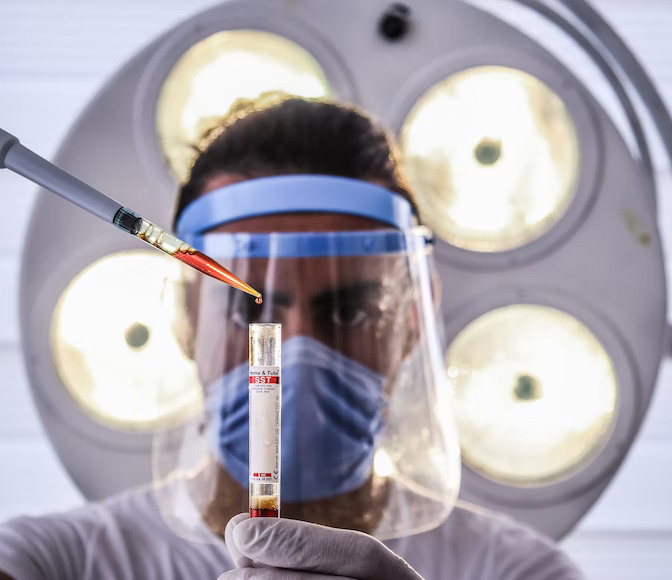Preventive Healthcare
Lactate Dehydrogenase (LDH) Test: What It Is, Need, Procedure and Result
4438 Views
0

Also known as lactic acid dehydrogenase, a Lactate Dehydrogenase Test measures the levels of LDH in bodily fluids. LDH is a form of protein, which is why it is known as an enzyme. LDH plays a crucial role in making energy for the human body. Almost every tissue in the body contains some extent of LDH, including the kidneys, heart, lungs and even the blood.
If there is any damage to the tissues, then LDH is released into the bloodstream or other fluids in the body. Thus, a high LDH level in the body is indicative of damage to a certain tissue in the body, either due to a disease or injury. An LDH test is thus used to discover whether you have any damage in your tissues or monitor disorders that can cause damage to tissues. These may include anaemia, lung diseases, liver diseases and certain other infections. This test may even be used to monitor the chemotherapy process and determine whether the treatment is working effectively.
Who Needs an LDH Test?
Depending on your health condition, you may need to get an LDH test done regularly. An LDH test is also performed to detect the causes of fluid buildup. This could be happening in the body due to several reasons such as injury or inflammation. It could also be brought about due to imbalances in the pressure in blood vessels and the composition of protein in the blood. The test can also help determine whether you have viral or bacterial meningitis.
Your doctor may ask you to get your LDH Levels tested for various reasons. These could be any of the following:
· To detect whether you have any tissue damage. If it is the case, the test will help detect the extent of the damage.
· To monitor any severe infection or health condition such as hemolytic anaemia, kidney diseases or liver diseases.
· To evaluate certain types of cancers during ongoing cancer treatment.
Normally, LDH levels are measured in the blood. In some cases, your doctor may ask to measure your LDH levels in the urine or cerebrospinal fluids.
What Happens During an LDH Test?
During an LDH test for an adult, a technician will draw blood from a vein at the back of the hand or the inner elbow. The sample can also be drawn from an infant, in which case, a lancet may be essential. Depending on the purpose of the test, your doctor may ask you to suspend certain medications for a relevant time frame before the test. This is because certain medicines can interfere with the test. It is known that a high concentration of Vitamin C may lower the levels of LDH in the blood. Similarly, components such as alcohol, aspirin, anaesthetics, narcotics and procainamide may raise the level of LDH in the blood. Very strenuous exercises can also raise the LDH levels in the blood. It is best to ask your doctor about the medicines which you should avoid right before the test.
What Do The Test Results Mean?
After getting yourself tested for LDH, your doctor will check the results to determine the range.
LDH is reported in units per litre (U/L). The LDH Normal Range in the blood is as follows:
| Age | Normal LDH level |
| 0 to 10 days | 290–2000 U/L |
| 10 days to 2 years | 180–430 U/L |
| 2 to 12 years | 110–295 U/L |
| Older than 12 years | 100–190 U/L |
A high level of LDH in the blood indicates that there is some form of tissue damage in the body. In case the levels of LDH are very high, it could be indicative of a very severe disease in the body or multiple organ failure. However, the test results of LDH alone cannot help a doctor determine the exact location or cause of damage to tissues. For this, additional tests may be required.
A low level of LDH may lead to a deficiency in the body, affecting how the body breaks down sugars for use as energy in the cells of the body. However, a condition of low LDH levels is quite rare in most cases. Certain genetic mutations can also cause low LDH levels in the body. It can lead to fatigue, muscle pain, and more. In some cases, there may be no symptoms at all.
Higher levels of LDH in the body can also pinpoint certain specific diseases such as anaemia, kidney diseases, liver diseases, muscle injury, heart attacks, pancreatitis, meningitis, and certain types of cancers. To make a proper diagnosis, your doctor may need to perform additional tests on you. This can include LDH isoenzyme tests which measure the different forms of LDH. This type of test can help your doctor detect the exact location, type and severity of the damage to a tissue in the body. There are no risks associated with getting a blood test done for LDH levels. You may only feel slight bruising at the spot where the needle is inserted. But in most cases, even that goes away in no time.
To Sum Up
LDH levels can vary in the body depending on the age of the person and the findings of an individual laboratory. Usually, the LDH levels are higher in younger children and infants as compared to older children and adults. You should talk to your healthcare provider to get a risk assessment and seek their consultation about the need for testing your LDH levels. The test result can help detect an underlying health condition, and early diagnosis can help to treat an infection at an early stage. In certain medical cases, testing LDH levels can be crucial to treat certain medical conditions. Within the normal range, test results can usually vary by some degree.
 Home Visit
Home Visit Upload
Upload














1701259759.webp)









 WhatsApp
WhatsApp